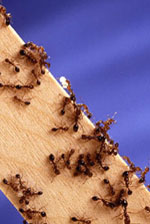Mortality Threats to Birds - Red Fire Ant (Solenopsis invicta)
Overview
There are two species of imported fire ants in the southeastern U.S. from North Carolina to Texas and Puerto Rico, the black fire ant and the red fire ant. The black imported fire ant arrived around 1918, and the red fire ant in the late 1930’s. They were introduced at the port in Mobile, AL from South America, probably in soil used as ballast in cargo ships. The red fire ant spread much more quickly than the black, and has replaced the two native fire ants and displaced the black imported fire ant. Fire ants disperse naturally through mating flights, colony movement or by rafting to new sites during floods. But the largest spread has been facilitated by humans by moving grass sod and woody ornamental plants used in landscaping. Isolated infestations have been found in California, Kansas, and Maryland.
Description
Imported fire ants have 10-segmented antennae with a 2-segmented club and the presence of a sting. Colonies consist of eggs, brood, polymorphic workers, winged males and females, and one or more reproductive queens. The winged forms are reproductive. At maturity, a fire ant colony can consist of over 250,000 ants. They often nest in mounds which are conically-shaped domse of excavated soil with a hard, rain-resistant crust. However, fire ants will nest in a wide variety of sites, including rotten logs, building walls, under sidewalks and roads, and in vehicles. They are omnivorous, feeding on any plant or animal material.
Birds Affected
In rural habitats, fire ants have a major impact on ground-nesting animals, including birds. In some instances, the depredation by fire ants has completely eliminated some species from an ecosystem. At the Mississippi Sandhill Crane National Wildlife Refuge, fire ants have invaded 19,000 acres of dry long-leaf pine savannah where endangered Mississippi Sandhill Cranes nest. Fire ants will devour freshly hatched chicks. They also impact Black-capped Vireo, and Golden-cheeked Warbler.
Control
Attempts to control fire ants over a large area are impractical, but local treatment can be effective of mounds and broadcasting bait. Insecticidal mound drenches can be done with carbaryl, diazinon, chlorpyrifos, and others, though extreme care should be exercised when using these chemicals, which can themselves be harmful to birds. These pesticides should be used only by experienced applicators with conservation background. |
